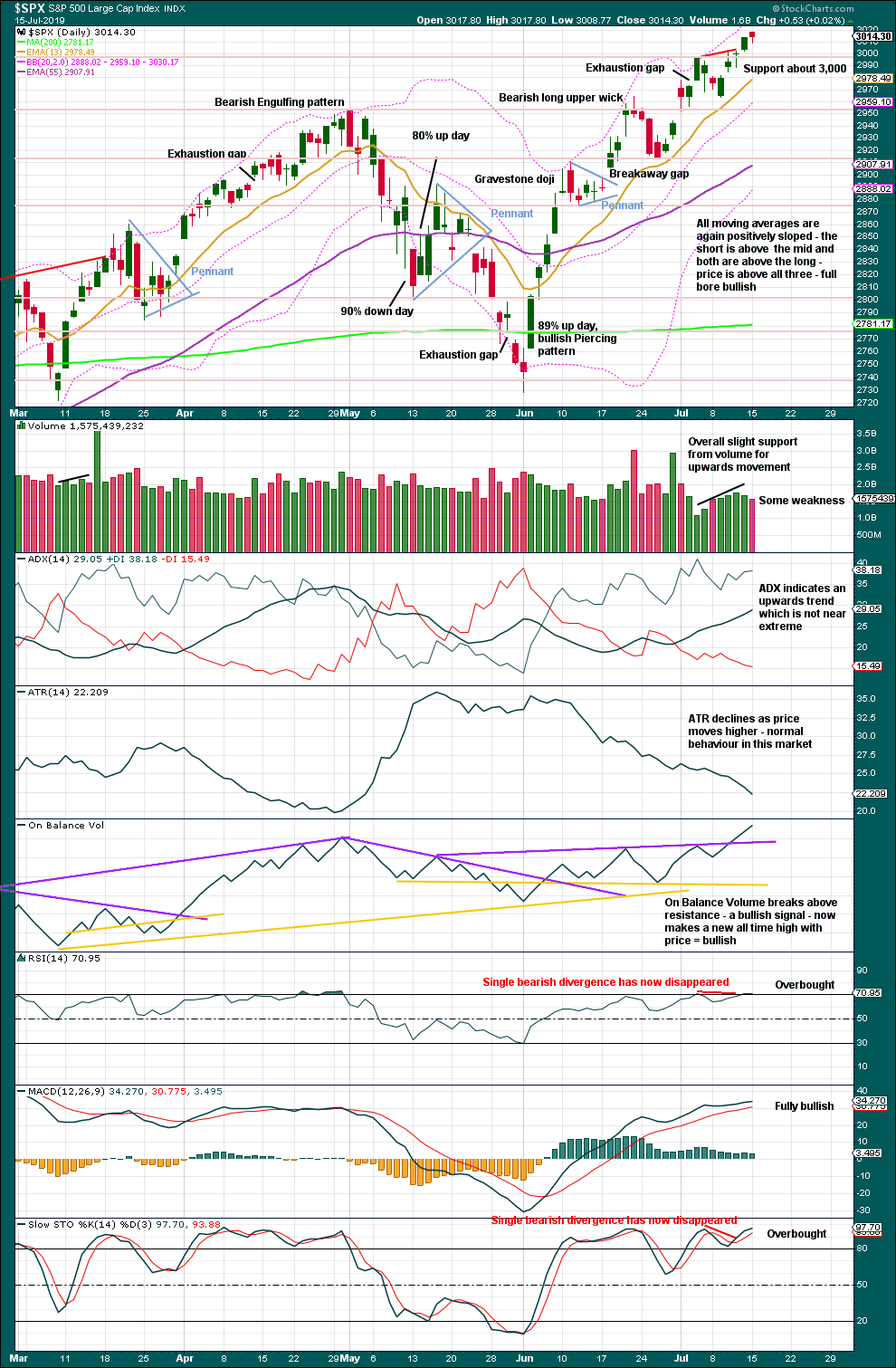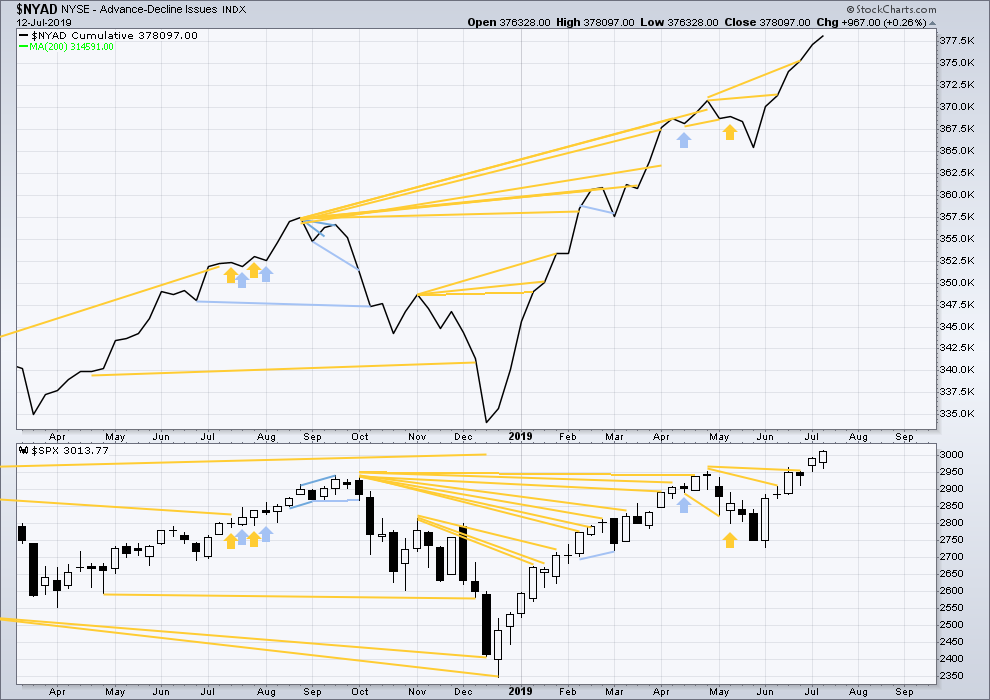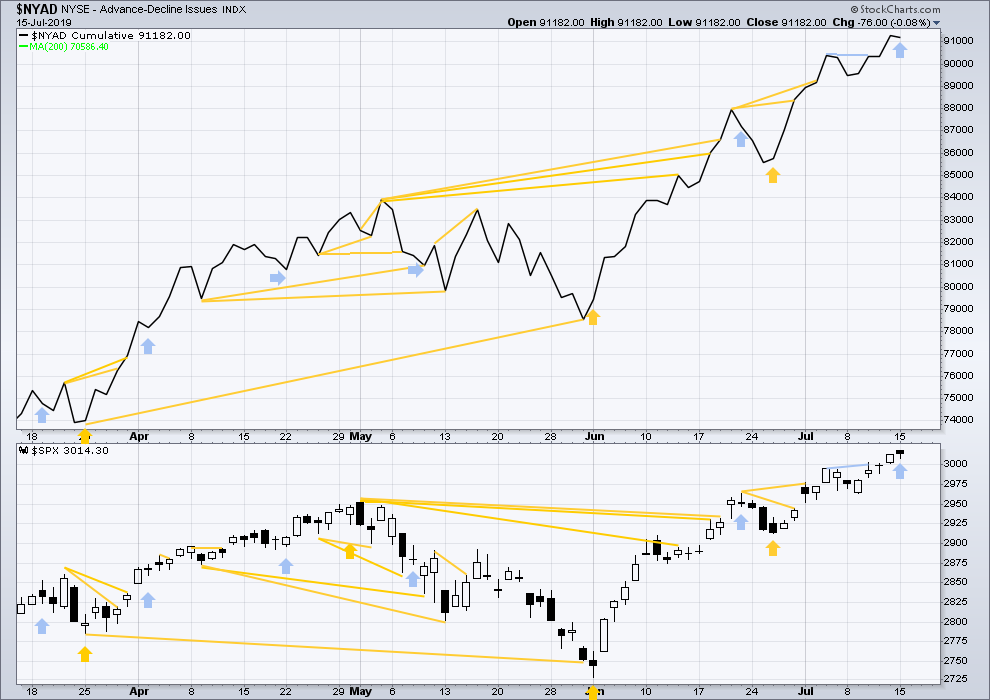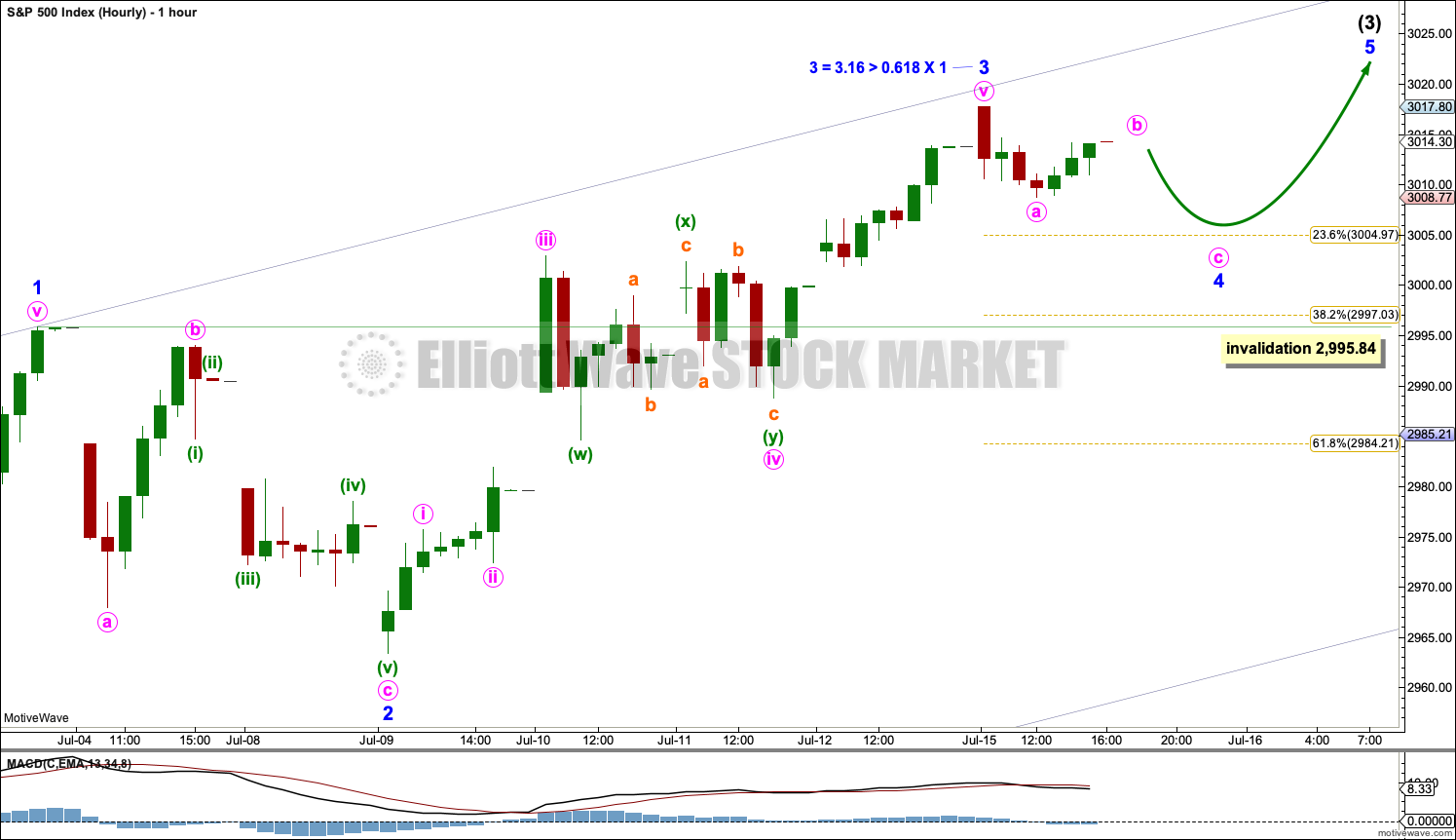Upwards movement was expected to continue. A new high today fits this expectation.
The two short-term Elliott wave counts today diverge very slightly, but the larger Elliott wave count remains exactly the same.
Summary: The bull market is expected to continue and corrections are expected to be shallow.
For the very short term, the main hourly chart expects a pullback to about 3,004.97 before the upwards trend resumes. This view has support from bearish divergence between price and both of the AD line and VIX.
The biggest picture, Grand Super Cycle analysis, is here.
Monthly charts were last published here, with video here. There are two further alternate monthly charts here, with video here.
ELLIOTT WAVE COUNTS
The two Elliott wave counts below will be labelled First and Second. They may be about of even probability. When the fifth wave currently unfolding on weekly charts may be complete, then these two wave counts will diverge on the severity of the expected following bear market. To see an illustration of this future divergence monthly charts should be viewed.
FIRST WAVE COUNT
WEEKLY CHART
The basic Elliott wave structure consists of a five wave structure up followed by a three wave structure down (for a bull market). This wave count sees the bull market beginning in March 2009 as an incomplete five wave impulse and now within the last fifth wave, which is labelled cycle wave V. This impulse is best viewed on monthly charts. The weekly chart focusses on the end of it.
Elliott wave is fractal. This fifth wave labelled cycle wave V may end a larger fifth wave labelled Super Cycle wave (V), which may end a larger first wave labelled Grand Super Cycle wave I.
The teal Elliott channel is drawn using Elliott’s first technique about the impulse of Super Cycle wave (V). Draw the first trend line from the end of cycle wave I (off to the left of the chart, the weekly candlestick beginning 30th November 2014) to the end of cycle wave III, then place a parallel copy on the end of cycle wave II. This channel perfectly shows where cycle wave IV ended at support. The strongest portion of cycle wave III, the end of primary wave 3, overshoots the upper edge of the channel. This is a typical look for a third wave and suggests the channel is drawn correctly and the way the impulse is counted is correct.
Within Super Cycle wave (V), cycle wave III is shorter than cycle wave I. A core Elliott wave rule states that a third wave may never be the shortest. For this rule to be met in this instance, cycle wave V may not be longer in length than cycle wave III. This limit is at 3,477.39.
The structure of cycle wave V is focussed on at the daily chart level below.
Within cycle wave V, primary waves 1 and 2 may now be complete. Within primary wave 3, no second wave correction may move beyond its start below 2,728.81.
Cycle wave V may subdivide either as an impulse or an ending diagonal. Impulses are much more common. Ending diagonals normally have second and fourth waves that are deep; the common depth is from 0.66 to 0.81 the prior wave. So far a correction within cycle wave V has not been deeper than 0.5, so a diagonal at this stage looks very unlikely (but remains possible).
In historic analysis, two further monthly charts have been published that do not have a limit to upwards movement and are more bullish than this wave count. Members are encouraged to consider those possibilities (links below summary) alongside the wave counts presented on a daily and weekly basis.
Daily charts below will now focus on price movement from the high of primary wave 1.
DAILY CHART
Cycle wave V must subdivide as a five wave motive structure. Within that five wave structure, primary waves 1 and 2 may be complete.
Primary wave 3 must move above the end of primary wave 1 (this rule has now been met). Primary wave 3 may only subdivide as an impulse.
Within the impulse of primary wave 3, intermediate waves (1) and (2) may both be complete.
Intermediate wave (3) may be incomplete. Intermediate wave (3) may only subdivide as an impulse. Within the impulse, minor waves 1 through to 3 may be complete. Within minor wave 3, no second wave correction may move beyond its start below 2,963.44.
When primary wave 3 is over, then primary wave 4 may be a shallow sideways consolidation.
Thereafter, primary wave 5 should move above the end of primary wave 3 to avoid a truncation.
Primary wave 1 lasted 86 sessions, 3 short of a Fibonacci 89. Primary wave 2 lasted 22 sessions, 1 longer than a Fibonacci 21. Primary wave 3 may end about a Fibonacci 55 sessions, give or take two or three sessions either side. This is a rough guideline only.
So far primary wave 3 has lasted 29 sessions.
Draw the best fit channel to contain all of intermediate wave (3). Draw the first trend line from the end of intermediate wave (1) to the end of minor wave 1, then place a parallel copy on the low labelled intermediate wave (2). Copy this channel over to the hourly chart.
MAIN HOURLY CHART
Both hourly charts are identical up to the low labelled minor wave 2. Thereafter, they look at the structure of minor wave 3 in two different ways. This hourly chart has some support from classic technical analysis today, so it is favoured.
Minor waves 1, 2 and now 3 may be complete. Minor wave 3 exhibits a Fibonacci ratio to minor wave 1, but it is shorter than minor wave 1. This limits minor wave 5 to no longer than equality in length with minor wave 3, so that minor wave 3 is not the shortest actionary wave within the impulse of intermediate wave (3) and this core Elliott wave rule is met.
Minor wave 4 may now unfold as a shallow sideways consolidation. Minor wave 2 was a shallow 0.39 zigzag or flat that lasted 20 hours (on lower time frames, minute wave a may have subdivided either as a three wave zigzag or a five wave impulse). Minor wave 4 may exhibit alternation as a more shallow structure. Minor wave 4 may subdivide as any one of more than 23 possible Elliott wave corrective structures. A new all time high within minor wave 4 may be seen as in minute wave b within an expanded flat, minute wave b within a running triangle, or minute wave x within a combination.
Minor wave 4 may not move into minor wave 1 price territory below 2,995.84.
Now the mid-term target for this wave count, which was at 3,148 for intermediate wave (3) to end, is removed. This is because it is no longer possible for the target to be met and for intermediate wave (3) to meet the rule stating that within it minor wave 3 may not be the shortest actionary wave.
ALTERNATE HOURLY CHART
Minor wave 3 may be incomplete. The short-term target for minor wave 3 to end remains the same.
Within the middle of this third wave, minute wave iv may not move into minute wave i price territory below 3,002.98.
SECOND WAVE COUNT
WEEKLY CHART
This weekly chart is almost identical to the first weekly chart, with the sole exception being the degree of labelling.
This weekly chart moves the degree of labelling for the impulse beginning in March 2009 all down one degree. This difference is best viewed on monthly charts.
The impulse is still viewed as nearing an end; a fifth wave is still seen as needing to complete higher. This wave count labels it primary wave 5.
TECHNICAL ANALYSIS
WEEKLY CHART

Click chart to enlarge. Chart courtesy of StockCharts.com.
Price has closed near the high for the week and volume supports upwards movement. This suggests more upwards movement this week. It is now possible that this expectation may be met and resolved.
Longer-term bearish divergence between price and RSI fits the Elliott wave count: the most extreme reading from RSI corresponds with the end of a third wave, and now a fifth wave at cycle or primary degree exhibits some weakness compared to the third wave.
DAILY CHART

Click chart to enlarge. Chart courtesy of StockCharts.com.
A close near the high for Friday suggests more upwards movement this week.
There is an upwards trend in place, which is not yet extreme, and there is room for the trend to continue a fair amount further. When this market trends, RSI and Stochastics may reach overbought and may remain there for extended periods of time. Sometimes divergence may develop and then simply disappear.
Look for resistance at round number pivots or Elliott wave targets.
There may now be strong support about 3,000, which may force pullbacks or consolidations here to be relatively shallow.
BREADTH – AD LINE
WEEKLY CHART

Click chart to enlarge. Chart courtesy of StockCharts.com. So that colour blind members are included, bearish signals
will be noted with blue and bullish signals with yellow.
Bear markets from the Great Depression and onwards have been preceded by an average minimum of 4 months divergence between price and the AD line with only two exceptions in 1946 and 1976. With the AD line making new all time highs again this week, the end of this bull market and the start of a new bear market is very likely a minimum of 4 months away, which is mid November 2019.
In all bear markets in the last 90 years there is some positive correlation (0.6022) between the length of bearish divergence and the depth of the following bear market. No to little divergence is correlated with more shallow bear markets. Longer divergence is correlated with deeper bear markets.
If a bear market does develop here, it comes after no bearish divergence. It would therefore more likely be shallow.
Last week the AD line again makes new all time highs with price. Upwards movement has good support from rising market breadth, indicating a healthy bull market.
Mid caps remain below their all time high of 24th April 2019, and small caps remain below their all time high of 25th February 2019. Weakness is beginning to develop in small caps and mid caps. This is normal behaviour during the later stages of a bull market, and may be expected to develop further before the bull market may end. Tops are a process and that process may last months to even years.
DAILY CHART

Click chart to enlarge. Chart courtesy of StockCharts.com. So that colour blind members are included, bearish signals
will be noted with blue and bullish signals with yellow.
Breadth should be read as a leading indicator.
Today price has moved higher, but the AD line has moved slightly lower. Upwards movement today did not have support from rising market breadth. This divergence is bearish for the short term and supports the main hourly Elliott wave count.
VOLATILITY – INVERTED VIX CHART
WEEKLY CHART

Click chart to enlarge. Chart courtesy of StockCharts.com. So that colour blind members are included, bearish signals
will be noted with blue and bullish signals with yellow.
The all time high for inverted VIX (which is the same as the low for VIX) was on 30th October 2017. There is now nearly one year and eight months of bearish divergence between price and inverted VIX.
The rise in price is not coming with a normal corresponding decline in VIX; VIX remains elevated. This long-term divergence is bearish and may yet develop further as the bull market matures.
This divergence may be an early warning, a part of the process of a top developing that may take years. It may not be useful in timing a trend change.
DAILY CHART

Click chart to enlarge. Chart courtesy of StockCharts.com. So that colour blind members are included, bearish signals
will be noted with blue and bullish signals with yellow.
Today price has moved higher, but inverted VIX has moved lower. Upwards movement today does not come with normal corresponding declines in VIX; VIX today increased. This divergence is bearish for the short term and, because it confirms bearish divergence with the AD line, it shall be given a little weight. This supports the main hourly Elliott wave count.
DOW THEORY
Dow Theory confirmed a bear market in December 2018. This does not necessarily mean a bear market at Grand Super Cycle degree though; Dow Theory makes no comment on Elliott wave counts. On the 25th of August 2015 Dow Theory also confirmed a bear market. The Elliott wave count sees that as part of cycle wave II. After Dow Theory confirmation of a bear market in August 2015, price went on to make new all time highs and the bull market continued.
DJIA: 23,344.52 – a close on the 19th of December at 23,284.97 confirms a bear market.
DJT: 9,806.79 – price has closed below this point on the 13th of December.
S&P500: 2,532.69 – a close on the 19th of December at 2,506.96 provides support to a bear market conclusion.
Nasdaq: 6,630.67 – a close on the 19th of December at 6,618.86 provides support to a bear market conclusion.
With all the indices having moved higher following a Dow Theory bear market confirmation, Dow Theory would confirm a bull market if the following highs are made:
DJIA: 26,951.81 – a close above this point has been made on the 3rd of July 2019.
DJT: 11,623.58 – to date DJT has failed to confirm an ongoing bull market.
S&P500: 2,940.91 – a close above this point was made on the 29th of April 2019.
Nasdaq: 8,133.30 – a close above this point was made on the 26th of April 2019.
Published @ 09:08 p.m. EST.
—
Careful risk management protects your trading account(s).
Follow my two Golden Rules:
1. Always trade with stops.
2. Risk only 1-5% of equity on any one trade.
—
New updates to this analysis are in bold.






Hourly chart update:
Minor 4 may now be complete.
Or, the degree of labelling may be moved down one, this may be only wave A of a longer lasting flat, or wave W of a combination. But at this stage I don’t think so. The proportions look okay, and there’s alternation with minor 2 already.
WOW- transports really ripping $IYT $TPOR
I decided to try small caps on this turn back up in the RUT, so I bought TNA.
I also took AMGN on it’s turning off a 61.8, and per my count, just finishing/finished a 2 down.
More stock updates, set ups and some of my own results at my site, specktrading dot com.
I was playing that in the last impulse but the returns were muted compared to the Dow and QQQ’s- rumor has it small caps are poor performers in ageing bull markets
All true. I’m just very short swing trading though; I’m out at +3%, ideally within a day or two. So wide ranging swings like this work okay for me.
nice simple website!
I have to make one in my own field (starting a telemedicine company)…
Thanks for all your input as always
Boom!